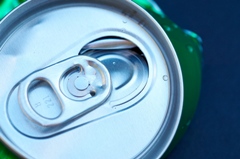 What does coal power have to do with popping a can of soda? This morning, NPR’s Anthony Kuhn reported on a power plant in China that is successfully capturing some of the carbon dioxide it releases. They extract it, liquefy it, and send it off to companies that use it in dry ice, fire extinguishers, and even carbonated beverages. A handful of power plants in U.S. are already doing the same.
What does coal power have to do with popping a can of soda? This morning, NPR’s Anthony Kuhn reported on a power plant in China that is successfully capturing some of the carbon dioxide it releases. They extract it, liquefy it, and send it off to companies that use it in dry ice, fire extinguishers, and even carbonated beverages. A handful of power plants in U.S. are already doing the same.
Of course, when it comes to reducing carbon emissions, capture is only half the battle. The carbon snared from these plants is only temporarily stored – it gets released eventually–like when someone pops the top of the soda can. It’s more like carbon recycling. The greater hurdle is in “sequestering” part of it. In order to make a lasting difference in cutting emissions, that carbon has to be stored permanently.
President Obama has signaled that developing carbon sequestration technology is a key part of his energy plan, and is handing out billions in stimulus dollars. But the U.S. is already behind the curve. While there are several ways to store carbon, the main focus has been on storing carbon underground in geologic formations. There are several power plants in Europe that are already capturing and sequestering carbon emissions underground. The Bush Administration backed off its first attempt at carbon capture and sequestration (CCS), the FutureGen project, in 2008 after the costs became too high. The name of game now is to simply get a demonstration plant working. Anywhere.
Here in California, CCS is an option, thanks to the underground geologic formations throughout the Central Valley that could be ideal sites. A western consortium known as WESTCARB is leading the charge with backing from the California Energy Commission and the Department of Energy. They’ve announced a pilot project in Bakersfield where carbon will be captured from a 50-megawatt power plant. But construction is described as still “months away.”
As with any new technology, cost is the make-or-break issue. Capturing and stashing carbon is prohibitively expensive–at least until there’s a price on carbon or the technology improves. This week, Energy Secretary Steven Chu said he doesn’t expect to see cost-effective technology for at least eight years. And he raised another point. “Even if the United States or Europe turns its back on coal, India and China will not,” Chu said. At last fall’s climate summit in Los Angeles, members of the Chinese delegation told Climate Watch that they were looking to the U.S. to provide key technology. But as Anthony Kuhn reported, the Chinese went to Australia to get technical advice.
It’s commonly forecast that coal will remain a central power source in the U.S. for decades to come. But as critics of carbon sequestration have stated, it’s really a question of whether cost-effective technology will arrive in time to slow down climate change.
Lauren Sommer is an associate producer with Quest at KQED, and a self-described “carbon geek.” Her story on plans for a “smart” electrical grid is Monday’s Quest Radio feature.
